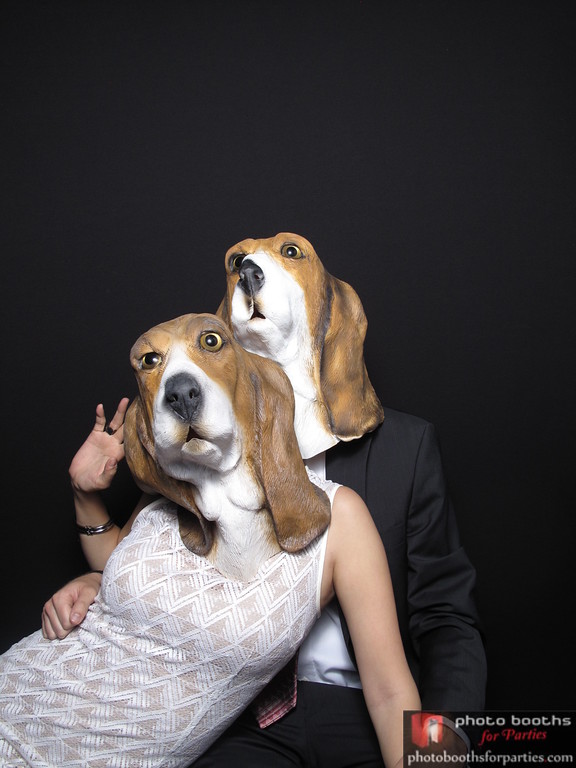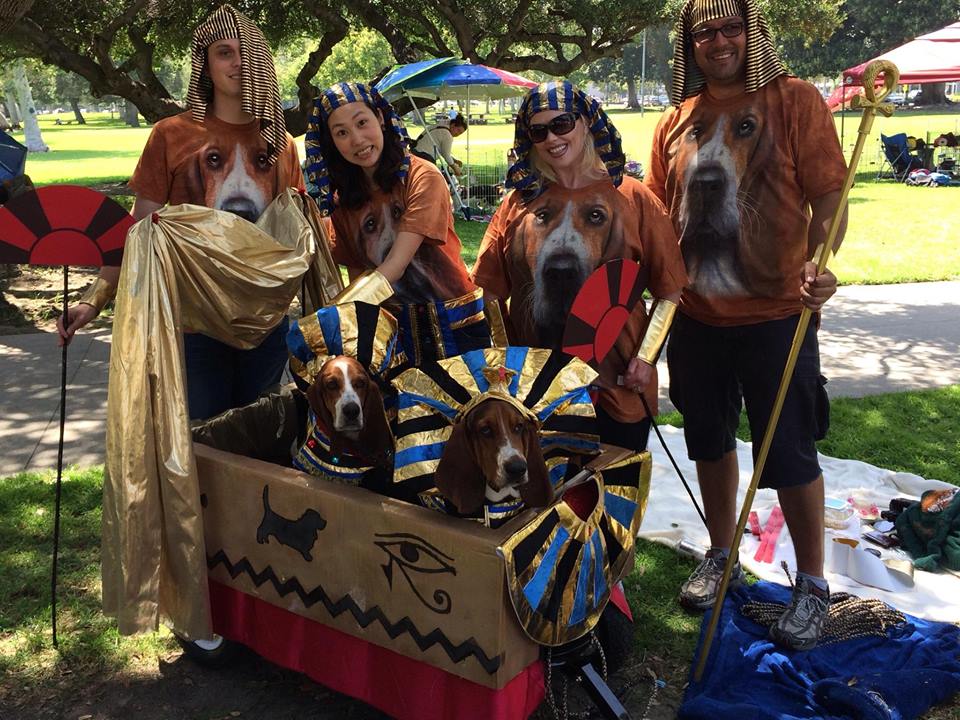In my husband’s closet, wrapped in an old blanket on the top shelf, is a stuffed basset hound named Sam. Sam is Matt’s oldest possession. Five years ago, when we were on the East Coast and his hometown of Santa Barbara was burning, Matt asked his sister to make sure to evacuate Sam.
“Why is his tongue gray?” I asked, when Sam moved into our home, a couple of years later.
“It’s not gray,” Matt said. “It’s pink.”

I was only vaguely aware of the existence of bassets until I started dating Matt. I don’t remember the first time he mentioned his nearly life-long interest in this specific dog breed—a fascination which, by the way, flourished despite his never owning one—but by our first Valentine’s Day together, I was printing out 4×6 photographs of bassets from the Internet, then cutting and pasting them into a calendar of iconic Los Angeles scenery—kind of a live Photoshop gag that involved basset hounds lounging in Griffith Park, by the Hollywood sign, on the back of a model woolly mammoth sinking into the La Brea Tar Pits. (This has now become an annual tradition, though since we got Duke, all photos have been of him—Duke layered into Kandinsky paintings, model train sets, and Chihuly glass.)
I have yet to meet a basset hound owner who isn’t wild about basset hounds—we all live our lives governed by these floppy, wiggly, spectacular dogs.
Matt extolled the basset’s virtues—the droopy ears, the sad eyes, the thick-bodied laziness. He showed me pictures and videos, pointed out how funny they were, how patently, sweetly ridiculous. He invited me to laugh at them, then to appreciate them, then, finally, to adore them. And because I was a malleable young woman newly in love, he groomed me into an enthusiast.
There’s a version of this story that ends with a break-up and a great story about the time I dated a basset hound fanatic. Instead I married into a world of hounds.

One day we were walking Duke in Los Feliz when a woman approached and asked to pet him. She showered him with hugs and kisses, and then, rising from the sidewalk, she showed us her basset hound tattoo.

We got Duke from the Basset Hound Rescue of Southern California, a vibrant non-profit organization with a strong social media presence, a dedicated newsletter (the Basseteer, both online and in print), regular events, and a rabidly basset-crazy core community. Every new homeless hound is welcomed online with a chorus of likes and comments, many of them from accounts bearing basset hound profile pictures (a couch full of basset hounds is a particularly popular shot). There are regular gatherings—a monthly “Brunch With Bassets,” food truck adoption events, wine fundraisers; there’s a “Houndaween Bites with Bassets” party around the corner, hosted at a fire department-themed restaurant.
But the centerpiece of BHRSC life is the annual Basset Hound Spring Games, an all-day Olympics-style extravaganza complete with tail painting, doggy massage, and a battery of sporting events. Each competition is a tribute to the basset hound’s unique characteristics. There’s a drooling contest, a kissing contest, a treat toss; ears are measured, as well as paws and ground clearance (the shorter the stature, the truer the hound). “Synchronized swimming” plays on the basset’s aversion to water—well known among us basset hound parents accustomed to tricking our dogs into baths. No actual swimming is required, only a quick walk across the length of an inflatable pool. Most hounds refuse to participate, and their stubbornness, their very failure, is met with applause and delight. Likewise the agility course, a set-up of obstacles almost designed to baffle these simple dogs, who are more inclined to jump on spectators than to run through hoops or navigate tunnels.
“His ears are too long,” Matt says, stroking them like ribbons of velvet. “His coat is too big,” he says, grabbing a handful of loose skin and shaking it gently, sending ripples across Duke’s dozing body.
Duke doesn’t really participate in these games. He’s a pretty unskilled guy, even for a basset. He won’t howl on command, never mind go near obstacles or water. Our family goes for the company (and to cheer on his best friend The Stig, who is a remarkable basset athlete), and for the spirit and energy of the gathering.

I like to think I’m as hip and snarky as the next young urban writer, but I’ve embraced the silly, earnest kitschfest that is basset hound culture. I love seeing hounds and humans dressed to the nines—tiny hats and costumes for bassets, basset-print clothing for humans. In this community, my basset hound cardigan—a coarse-knit sweater featuring no fewer than four bassets and the words “Basset Hound” stitched where it hits my waist—is an object not of laughter, but of deep, marveling envy. Basset nation’s font of choice is Comic Sans; our art involves cartoonish lawn ornaments and wonderfully sloppy acrostics. None of this is ironic: The goofiness is a sign of appreciation, of love. It is a clumsy attempt to distill the singular essence of bassets into a mortal, human subculture.
I have yet to meet a basset hound owner who isn’t wild about basset hounds—we all live our lives governed by these floppy, wiggly, spectacular dogs. We’ve bought into the idea that they’re more than just pets—they’re gifts and miracles, worthy of celebration. For most of the year, Matt and I live in a world where basset hounds are just one of many dog breeds, where people can walk past Duke on the street without falling to their knees to touch his ears and his coat, and we have to pretend that this lack of adulation is something we understand. What a relief, what a rush, then, to come together with all these bassets and basset people, who know what we know, who see what we see.

We have won one contest at the Spring Games—last year’s costume contest, in conjunction with The Stig and his parents, Jennifer and Iden. We outfitted the boys in pharaoh costumes, while we humans dressed up as their entourage, wearing basset hound T-shirts with our ancient Egyptian servant accessories. The Stig’s parents are as mad about bassets as we are, but with much sharper artistic aptitude, and they built a hand-painted golden chariot for the hounds, which Matt and Iden pulled while Jennifer and I brought up the rear, fanning our sons. (The Stig is, I should note, a bit of an Instagram celebrity and doggy socialite. We’ve met several of his fans and acquaintances just by walking our own basset around town.)

“The joke is that it’s not really a costume,” Jennifer said. “This is pretty much our Tuesday nights at home.”

There was a time when I was certain Matt would love any potential basset more than I ever could. I’d never especially cared for dogs, and I didn’t think I could convert so late in life and match his level of devotion. But like many new parents agnostic about parenthood, I fell for my baby the day I met him, head over heels. Matt and I agree on the exact moment this happened—we took him for a walk around his foster family’s block, and, 10 minutes in, he found a tiny palm tree and flopped down in its tiny splash of shade, refusing to move, enjoying his respite from the exercise and heat. I will never forget that moment. I’d put it in stained glass if I could.
If a cult is built upon a shared agreement that our rules and perceptions supersede those of the wider world, then Matt and I are in a cult of two, with Duke at its center.
I’m not sure what the two of us talked about before we had Duke. There isn’t a thing about him that we haven’t both praised and ridiculed. (“His ears are too long,” Matt says, stroking them like ribbons of velvet. “His coat is too big,” he says, grabbing a handful of loose skin and shaking it gently, sending ripples across Duke’s dozing body.) At times our life resembles that strange scene in Being John Malkovich, where, in lieu of conversation, we are sighing and laughing and exclaiming, “Basset, basset, basset.” Day in and day out, I serenade Matt with basset hound songs—“Howlellujah,” “The Sound of Bassets”; “525,600 bassets, 1,051,200 ears.” He listens and helps me shape new rhymes. We engage in a continuous private worship of embarrassing intensity.
If a cult is built upon a shared agreement that our rules and perceptions supersede those of the wider world, then Matt and I are in a cult of two, with Duke at its center. Maybe there’s nothing unusual or even interesting about this. Maybe we’ve only circumscribed to our own cell in the universal cult of parenthood. But I look at Duke—his soulful eyes, his pouchy mouth, the way he flops on his side to howl at a bone that’s slid under a bookshelf—and I know in my heart that he’s the world’s most perfect creature. It may be that every parent cherishes a similar, private conviction; but I’m the only one who’s right.
Cults and (Sub)cultures is Pacific Standard‘s series of reported essays on all things cult, from religion to pop culture.





